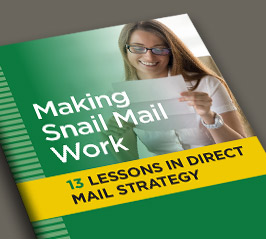
How to choose the right mailer format
In direct marketing , you have a choice of direct mail formats. There are letter mailers, self-mailers, postcards, mailers with brochures, booklet mailers, catalogs and three-dimensional mailers.
While we all have our personal favorites, choosing the right direct mail format for your campaign requires more thought than your personal preferences.
You also need to consider the objective of the campaign, the complexity of the product or service, the expectations of your audience, the response methods and your budget.
What is a direct mail format?
A direct mail format refers first to the type of mailer (an envelope mailer vs. a self-mailer) and second, to the components or other specifications of the mailer.
Self-mailers vs. letter mailers
Direct mail formats fall into two categories – self-mailers and letter mailers.
Self-mailers are self-contained mail pieces that require no envelope.
Letter mailers have an outer envelope and generally contain a letter, reply device and possibly additional inserts.
Types of self-mailers
By definition, a self-mailer is any direct mail that is mailed without an outer envelope. Self-mailers range in sizes and formats:
- postcards (multiple sizes)
- single fold self-mailers
- double fold self-mailers
- triple fold self-mailers
- multiple-page booklets
Advantages of the self-mailer
Self-mailers are often selected because of their relatively low production costs. By definition, a self-mailer is mailed on its own without an envelope. This means it is printed and mailed as once piece (instead of multiple pieces in a direct mail package) which saves on printing and mail inserting costs.
Self-mailers are also selected because they are more likely to be passed around the office or the home. Personalized letter packages are almost never opened and read by anyone but the addressee. But because self-mailers look less personal, business colleagues and family members are not uncomfortable with looking at someone else’s mail. This pass-along effect can increase readership and response.
Finally, many people choose self-mailers because they seem to offer more creative opportunities – with more photos and more graphics.
How self-mailers are used
Self-mailers range from a postcard to a simple one-fold, two-fold or three-fold piece (in multiple sizes) to a more complex multi-page booklet.
The simple self-mailers are most often used for lead generation or retail traffic building applications. Multi-page booklet formats are used for product catalogs, conference mailings and seminars in which a longer message is required.
The first question to ask in planning a self-mailer is how much space will you need to create this mailer and accomplish your objective.
Lead generation mailers require less space than direct selling (mail order) mailers. Familiar and simple products require less space than new and complex products.
Types of letter mailers
Letter mailers are typically described by the size or type of envelope being used:
- #10 package
- 6×9 package
- 6×11 package
- 9×12 package
- invitation package
- special format package
- dimensional package
Components of a letter mailer
Letter mailers are further described by what goes into the envelope. This will vary with the objective of the mailing. Lead generation mailers will likely only have the essential elements – an outer envelope, a letter and a reply device. But a more complex direct selling package may also include a brochure and possibly other components as well.
Essential components of a letter mailer
- outer envelope
- letter
- reply device
Optional components of a letter mailer
- brochure
- sell sheet
- lift note
- price list
- premium sheet
- testimonial sheet
Advantages of the letter mailer
Letter mailers are considered the traditional direct mail package. This goes back to the earliest days of direct marketing when mail-order businesses used the mail not to advertise or generate leads, but to actually sell.
Letter mailers are still popular today because they have proven to work. They are not as sexy or graphically exciting as self-mailers, but the numbers speak for themselves.
While not for every direct marketing application, a letter mailer is usually the format of choice if there are no compelling reasons to choose one format over another.
Letter mailers tend to have a more serious and professional look than a self-mailer. They can be designed to look like a personal letter or an important piece of correspondence – which increases the chance they will be opened and read.
How letter mailers are used
Letter mailers serve two purposes:
- to carry multiple inserts that may be needed to accomplish the direct mail goal
Direct mail strategy dictates that when your goal is to actually sell a product (not generate a lead), you need to provide the reader with a lot of explanation, proof and reassurance. This often requires multiple sales messages presented as separate inserts.
As noted above, direct mail envelope packages can contain a variety of inserts that each serve a purpose. While it’s true that these inserts could be combined into into one component (and they sometimes are), keeping them separate could improve the response rate.
- to convey a personalized “look and feel”
Personalization is an important part of direct mail marketing. At a minimal level, this means simply using the name and address of the prospect on the envelope. It may also mean personalizing the letter, the reply card and perhaps some other inserts.
Direct mail marketers use personalization because they know (through testing) it often improves response (albeit at an additional cost).
Some marketers work very hard to make their direct mail package look like a letter you would get from a friend or a business acquaintence. They want more than anythng else to avoid looking like advertising mail.
ort: Making Snail Mail Work: 13 Lessons in Direct Mail Strategy
If you’d like to discuss an upcoming campaign – or if you’re looking for ways to improve an existing mailing program – call us and let’s schedule an introductory call.

